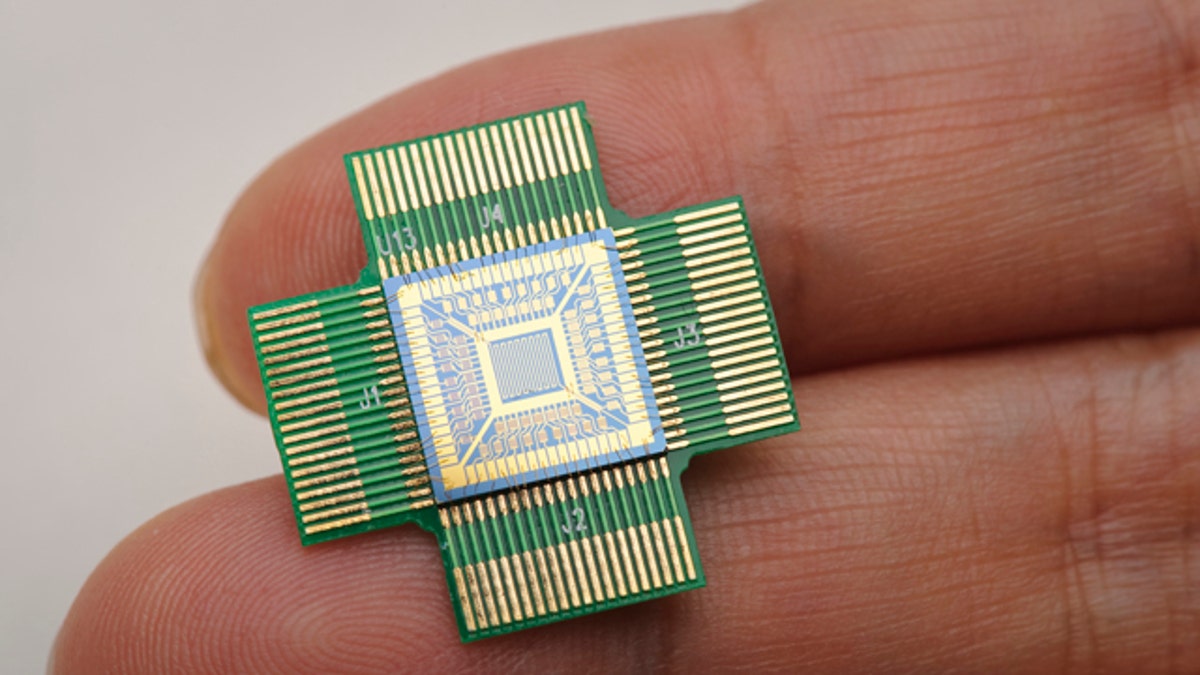
A silicon-based sensing chip, which consists of 64 nanosensors and is less than one square centimeter, can turn a cell phone into a portable poison detector. (Dominic Hart/NASA)
A silent killer threatens a family with a baby in a hotel room.
Fortunately, their smartphone wises up, senses the threat and notifies the authorities -- and the local fire department charges in to the rescue, saving the day.
This is no hypothetical scenario: As of this week, new technology can turn your cellphone into a portable “silent killer” detector. And in the near future, this technology has the potential to convert the average cellphone into a handheld detector capable of warning you of chemical warfare attacks and automatically calling for help.
On Wednesday, the Department of Homeland Security Science and Technology division demonstrated at the California Fire Department’s training center exactly how this new technology, known as Cell-All, can save lives.
The threat of carbon monoxide, the silent, odorless, lethal gas known as the "silent killer," lurks in the average home and leads to at least 2,000 unintentional poisoning incidents per year. Experts believe the figure is far greater than this; poisoning can lead to flu-like symptoms and therefore go undiagnosed or unreported.
Appliances fueled with gas, oil, kerosene or wood, if defective or poorly operated, can produce the gas. Prolonged exposure can lead to unconsciousness and death. Several hundred Americans are killed by CO1 each year.
In a Cell All-enabled phone, a sensor picks up a threat and the user has three options to choose to deploy: set off an alarm to wake the phone’s owner, send a text message to warn emergency contacts, and send out a "bat signal" (similar to a 911 call) to a commercial monitoring provider or local first-responder.
As of this week, Synkera Technologies has a Bluetooth version developed with DHS available to the public for trial and evaluation. An external sleeve that would go over the phone -- and was developed by NASA's Center for Nanotechnology with a major smartphone manufacturer -- may soon be available as well.
Direct integration into cell phones is about 18 months out, and expected to become widespread, just like the cameras that were once only available on certain models. DHs anticipates that Americans will want to protect themselves and their loved ones from the silent killer. The Cell-All sensor will become widely available after two phone cycles in three years' time, they predict.
Built for first responders, too
The Cell-All program has also developed a specific model, known as Chem-Tag, to address the toxic gas threats faced by American first responders -- carbon monoxide, methane and hydrogen cyanide. Working closely with FEMA’s Domestic Preparedness Center, this technology was adapted to detect a range of harmful gases and comes in a sensor built to withstand both high degrees of heat and moisture that are typical of a burning building.
The first versions of Chem-Tag will be available for trial in the next six months. Currently, it's a self-contained unit, but they are looking at incorporating it into the clothing that a firefighter ordinarily wears.
Beyond tackling the silent killer and warning first responders of gas threats, the Cell-All initiative has developed over 100 other prototypes this year with a wide range of applications. For example, the team has a version that could be deployed in cellphones to protect employees working in industrial chemical environments by alerting them to an exposure threat.
DHS S&T has even looked at detecting the threats hidden in the humble nail salon down your street, developing a sensor to specifically target dibutyl phthalate, formaldehyde and toluene -- known as "the deadly trio" in the nail business.
Hand-held WMD detectors
Ultimately, Cell-All could be American’s secret weapon against public threats at football stadiums or sarin gas-style attacks like the one that killed 13 people in Tokyo's subway system in 1995. Experts are always working hard to find ways to reduce the risk to Americans at large events that could be attractive targets to terrorists.
You might be entirely unaware of a chemical attack that Cell-All could detect automatically, whether in a stadium, subway or mall. Harnessing a vast network of cellphones equipped with this technology defeats false positives with multiple signal validation and widens the net well beyond what stationary sensors can currently provide.
"This innovative capability’s time has come," DHS S&T program head Stephen Dennis said. And the power to detect, identify and notify authorities in under 60 seconds is a most welcome advance to protect Americans indeed.
Ballet dancer turned defense specialist Allison Barrie has travelled around the world covering the military, terrorism, weapons advancements and life on the front line. You can reach her at wargames@foxnews.com or follow her on Twitter @Allison_Barrie.
